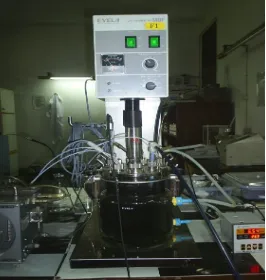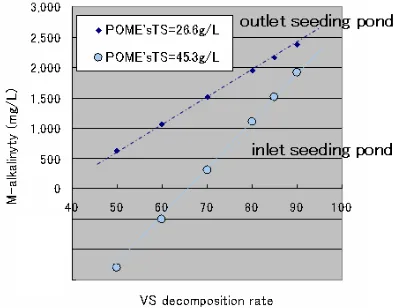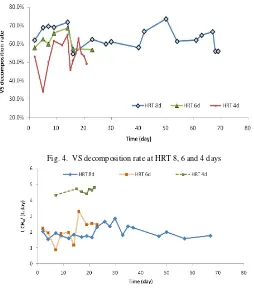In te rn a tio n a l Jo u rn a l o f
Sc ie n c e a n d En g in e e rin g
( IJSE)
H a l f y e a rl y p u b l i c a t io n
IS S N : 2 0 8 6 - 5 0 2 3
ijse
Vo l.
3
Issue :
1
Ap ril
2012
Internat. J. of Sci. and Eng., Vol. 3(1):32-35, April 2012, Irvan et al. ISSN: 2086-5023
32
Methane Emission from Digestion of Palm Oil Mill
Effluent (POME) in a Thermophilic Anaerobic
Reactor
Irvan
#1, Bambang Trisakti
#2, Vivian Wongistani
#3, Yoshimasa Tomiuchi
*4#Chemical Engineering Department, University of Sumatera Utara
Jl. Almamater Komplek USU Medan 20155 Indonesia
1 concern, many studies to reduce CO2 and CH4 gases (greenhouse
gases, GHG) have been implemented in several countries, including in Indonesia. Considering that Indonesia has a huge numbers of palm oil mills, no doubt if their waste water treatment as one of the major sources in GHG. This paper presents the results from a research project between Metawater Co., Ltd.-Japan and University of Sumatera Utara-Indonesia. The objective of the research is to study the methane emission of thermophilic fermentation in the treatment of palm oil mill effluent (POME) on a laboratory scale. Anaerobic digestion was performed in two-litre water jacketed biodigester type continuous stirred tank reactor (CSTR) and operated at a thermophilic temperature (55 oC). As raw material, a real liquid waste (POME) from palm oil mill was used. Fresh POME was obtained from seeding pond of PTPN II waste water treatment facility which has concentration of 39.7 g of VS/L and COD value of 59,000 mg/L. To gain precise results, complete recording and reliable equipment of reactor was employed.As the experimental results, for hydraulic retention time (HRT) 8 days, VS decomposition rate of 63.5% and gas generation of 6.05-9.82 L/day were obtained, while for HRT 6 and 4 days, VS decomposition rate of 61.2, 53.3% and gas generation of 6.93-8.94 and 13.95-16.14 L/day were obtained respectively.
Keywords
—
methane (CH4), palm oil mill effluent (POME),anaerobic digestion, thermophilic, green house gases (GHG)
I. INTRODUCTION
Global climate change as the effect of greenhouse gases (GHG) emissions has been a significant driving force of researches done in recent periods. Such objective of reducing the GHG emissions was clearly emphasized in Kyoto Protocol 1997 (Brown et.al., 1998). Many researches have been conducted regarding the effects on climate change which affect the GHG emissions (Yacob et. al., 2005; Le Mer and liquids with their concentration above the threshold value that are harmful to the environment (Igwe and Onyegbado, 2007).
Regarding to this, it is very important to treat these effluents to land application, while upper product includes biogas mixture having 65% CH4, 35% CO2 and traces of H2S are uncontrollably released to the atmosphere (Ma et.al., 1999). According to the previous study, 1 tonne of POME may give approximately 28 m3 biogas (Quah and Gillies, 1984).
Anaerobic digestion, which uses microorganisms in anoxigenic conditions to stabilize the organic matter by transforming it into methane and other inorganic products, has a high potential to be chosen as treating method for POME. This method involves a group of microorganism digesting organic matters to produce methane and carbon dioxide as major components in biogas. The effluents of anaerobic digestion comprises both of biogas and liquid effluent, which are respectively, useful as energy source and fertilizer (Choorit and Wisarnwan, 2007).
So far, there are still very few researches to study the performance of anaerobic digestion, using POME as the raw material. Therefore, this paper will discuss the biogas properties and emission pattern of POME anaerobic digestion using continuous stirred tank reactor (CSTR). To provide better insight, properties of POME used were preliminarily analysed. Main variables used as performance criteria were specific methane production, volatile solid decomposition and volumetric composition of biogas.
II. EXPERIMENT,MATERIALS AND METHODS
A. Experiment
33 composition (CH4, CO2, H2S) were completed at external
laboratory.
Nearly all equipments involved were electricity driven. Feeding and temperature recordings were done automatically, as well as mixing and operations of biodigester.
B. Materials
Real POME used as raw material for this experiment was obtained from palm oil mill belong to PTPN II located at Perbaungan, North Sumatera, Indonesia. The POME was collected from seeding pond inlet and outlet of waste water treatment facilities. Fig.1 shows the facilities layout which has total volume 145 m3. Before being fed into the biodigester, POME taken from the seeding pond was characterized. Table I summarizes the main physical and chemical properties of this material.
Fig. 1. PTPN II waste water treatment facilities layout TABLEI the experiment. The usage of this POME, which has CODcr of 38,000 mg/L and 21,800 mg/L of VS, was stopped, due to the productivity of biogas was very low. In addition, TS value became instable and the pH of fermentation liquid tended to decline sharply.
Based on the problems above, new POME from inlet of seeding pond, which has higher CODcr and VS value, was applied as substrate. The loading up process took about 9 days to reach HRT of 8 days. Feeding and discharge were done automatically 6 times in a day, having an interval of 4 hours (intermittent).
The fermentation process took place in a 2-litre-capacity transparent jar digester (EYELA, Model MBF 300ME) which was provided with double walled water jacket to control the temperature, valves for sampling, conduit for discharge and feeding, turbine propeller, and alarm indicator bulb anticipating temperature disorder. A data logger (KEYENCE,
Model NR-250) was connected to computer to enable automatic recording of temperature and pH provided by censoring equipments attached to digester. Two litre biodigester for experimental equipment is shown in Fig 1.
Each litres of POME before put into the feed tank was added with 2.5 g NaHCO3 for pH adjustment and 300 micro-litters of premixed chemical solution (FeCl2, NiCl.6H2O and CoCl2.6H2O). These solutions are essential nutrition for methano-bacteria.Amount of gas generated, pH, feeding and discharged amount of digested slurry were measured daily, while TS and M-alkalinity of digested slurry, and VS of POME were analysed three times a week. To ensure the accuracy, pH electrode was calibrated once in two weeks. The measurement of total solid, volatile solid and ash, M-alkalinity and pH value were in accordance with Japanese Standard Methods for the Examination of Water and Wastewater.
Fig. 1. Two-litre biodigester used for POME fermentation
III.RESULTS AND DISCUSSIONS
A. Comparison of two kinds of POME
As briefly explained before, prior to substitute POME from inlet seeding pond (new POME), experiment has been performed using POME from outlet seeding pond (old POME) operated at HRT 8 days. Table II and Fig. 2 show properties of digested slurry from different POME.
As shown in Table II, all the parameters of digested slurry using old POME were lower than those using new POME. More over fluctuation of data produced using old POME were quite larger than using new POME. We calculated that
Internat. J. of Sci. and Eng., Vol. 3(1):32-35, April 2012, Irvan et al. ISSN: 2086-5023
34 insufficient, because Kj-N concentration of the new POME
(760 mg/L) was 1.1 times more than that of the old POME (680 mg/L), while TS concentration of the new POME (45,300 mg/L) was 1.7 times more than that of the old POME (26,600 mg/L).
Fig. 2 VS decomposition rate and M-Alkalinity of different POME at HRT 8 days.
B. Study of the 2-L biodigester performance at various HRTs
Laboratory scale experiments were performed at various HRTs i.e. 4, 6, and 8 days. Table III shows the performance of the biodigester at different HRT.
Before being introduced into the digester, POME as the raw material has been added with chemical substances, i.e. NaHCO3, premixed chemical solution (FeCl2, NiCl.6H2O and CoCl2.6H2O) and NH4HCO3. Among the four variations of HRT being discussed, none had the same amount of those chemical substances addition. The only one given in the same amount to all HRT was the premixed metal solution.
TABLEIII
PERFORMANCE OF THE BIODIGESTER AT VARIOUS HRTS
Parameters HRT (days) 4 6 8
Real HRT (d) 3.94 6.1 8.23
VS decomposition rate (%) 53.3 61.2 63.5
Gas generation (Nm3/t-VS) 590 460 610
CODcr decomposition rate (%) 70 - 77
CH4 concentration (%) 67 66 64 CH4 generation per COD in
substrate (kg CH4/kg COD)
0.16 0.17 0.17
Previously, POME for HRT 8 days was only added with 1.5 g NaHCO3/L; after that, it was increased to 2.5 g NaHCO3/L and also given 0.565 g NH4HCO3/L. These actions were applied to overcome the low VS decomposition rate
which is predicted due to insufficient of M-alkalinity and low nitrogen concentration in the digested slurry.
In the mean time, during the whole process at HRT 6 days, the POME was still added with NaHCO3 however with lower amount, i.e. 1.5 g/L. Consequently, it caused several problems including low VS decomposition rate, relative low value of pH and several times drastic drops of volume of biogas generated daily.
On the other hand, at HRT 4 days, digestion process was ‘well-armed’ by nitrogen supply, considering that for 1 litre POME was added by 5 g NaHCO3/L and 2.8 g NH4HCO3/L. This was not done without logic consideration, as the large amount of POME to be digested per day incline quite high, meaning more bacteria will exist and need more nitrogen for their growth.
Fig. 3 Methane concentration in biogas and volume of biogas produced daily at HRT 8, 6 and 4 days
As described in Fig. 3, a significant increment was gained in terms of gas generation, when HRT increased from 8 to 4 days. This is a normal change, considering that the amount of POME fed to digester also increased twice. However, this natural trend could not be found in the case of HRT 6 days, at which the gas generation fluctuated and in fact, lower than that of HRT 8 days. Maximum amount of 9.82 L/d gas generation at HRT 8 days grew high drastically to maximum level of 16.14 L/d when HRT was switched to 4 days. At HRT 6 days, it only touched the maximum amount of 8.94 L/d.
35
Fig. 4. VS decomposition rate at HRT 8, 6 and 4 days
Fig. 5 Comparison of specific methane production among HRT 8, 6 and 4 days
On the contrary, CH4 concentration of HRT 4 days was 67%, quite high compared to that of HRT 6 and 8 days which were 66% and 63%, respectively.
Another interesting variable was the specific methane production which fluctuated for HRT 6 days as shown in Fig. 5. Digestion at HRT 4 days was relatively high and having consistent value of specific methane production, while both HRT 6 and 8 showed lower values and nearly similar to each other.
Fig. 6. Trendline between VS decomposition rate and HRT
The unexpected situations happened to experiment at HRT of 6 days, where biogas generation sometimes dropped
suddenly to a very low level, low value of VS decomposition rate, and also low pH. However, it was still undetermined yet, if HRT of 6 days could be used in a stable condition of digestion due to the raw material that was not provided well by sufficient nitrogen supply. Yet, using prediction provided by Fig. 6, HRT 6 days only contributed about 58% of VS decomposition rate, which is not considered as satisfying.
For HRT 8 days, the digestion process seemed to be better and acceptable. But even at this HRT, some attributes of biogas and other digestion results have not reached the values as reported in other publication. Fig. 6 suggests a minimum HRT of 24 days to be used in order to gain VS decomposition rate of 80%.
IV.CONCLUSIONS
The facts and considerations discussed previously suggested that high rate operation at HRT of 4 days should not be applied for POME treatment with CSTR design, because of system instability occurred. Furthermore, at HRT of 4 days, destruction of fat contained in POME was considered to be not high enough, resulting in accumulation of fat and clogging in discharge tubing. The fat loading at HRT 4 days was calculated to be approximately 2.0 g/L/d, whereas, maximum loading was 1.6-1.7 g/L/d. The low destruction of fat was the possible cause of low decomposition rate at HRT of 4 days.
ACKNOWLEDGEMENT
This research was supported by Hibah Kompetitif Penelitian Unggulan Strategis Nasional fiscal year 2012 and METAWATER Co.,Ltd-Japan.
REFERENCES
[1] A.N. Ma, T.S. Toh, N.S. Chua, “Renewable energy from oil palm industry,” in G. Singh, K.H. Lim, T. Leng, L.K. David, (Eds.), Oil Palm and the Environment: A Malaysian Perspective. Malaysia Oil Palm Grower’s Council, Kuala Lumpur, pp. 113-126, 1999.
[2] G. Gonzlez-Gil, R. Kleerbezem, G. Lettinga,”Assessment of metabolic properties and kinetic parameters of methanogenic sludge by on-line production rate measurement,” Appl. Microbiol. Biotechnol., vol. 28, pp. 248-254, 2002.
[3] J.C. Igwee, C.C. Onyegbado,”A review of palm oil mill effluent (POME) water treatment,” Global Journal of Environment Research, I (2), pp. 54-62, 2007.
[4] J. Le Mer, P. Roger, “Production, oxidation, emission and consumption of methane by soils: a review,” Eur. J. Soil Biol., vol. 37, pp. 25-50, 2011.
[5] P. Agamuthu, “Palm oil mill effluent‒treatment and utilization,” in Sastry, C.A., Hashim, M.A., Agamuthu, P. (Eds), Waste Treatment Plant. Narosa Publishing House, New Delhi, pp. 338-360, 1995. [6] P. Brown, N. Kete, R. Livernash, “Forest and land use projects,” in
Goldemberg, J. (Ed.), Issues and Options: The Clean Development Mechanism. United Nations Development Programme, 1998. [7] S.K. Quah, D. Gillies, “Practical experience in production and use of
biogas,” in Proceeding of National Workshop on Oil Palm By-products. Palm Oil Research Institute of Malaysia, Kuala Lumpur, pp. 119-126, 1984.
[8] S.Yacob, M.A. Hassan, Y. Shirai, M.Wakisaka, S. Subash, “Baseline study of methane emission from open digesting tanks of palm oil mill effluent treatment,” Chemosphere, vol. 59, pp. 1575-1581, 2005. [9] W. Choorit, P. Wisarnwan, “Effect of temperature on the anaerobic


